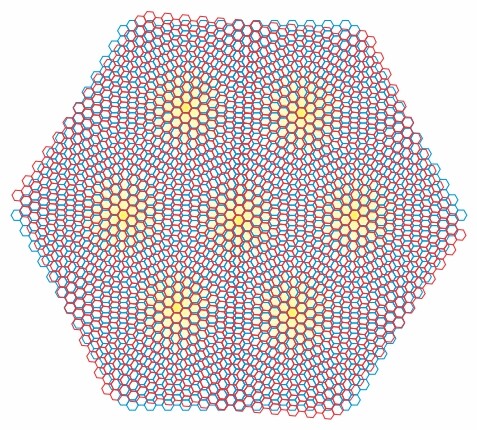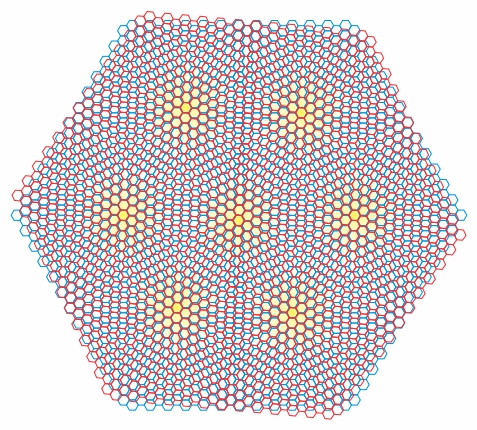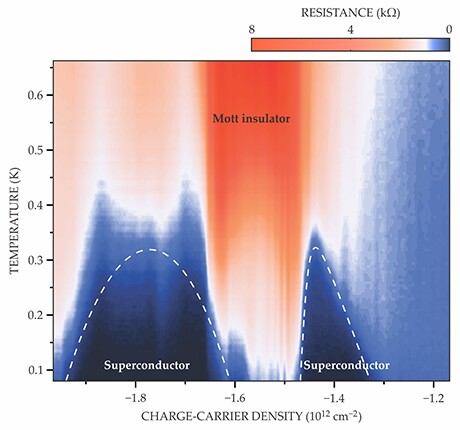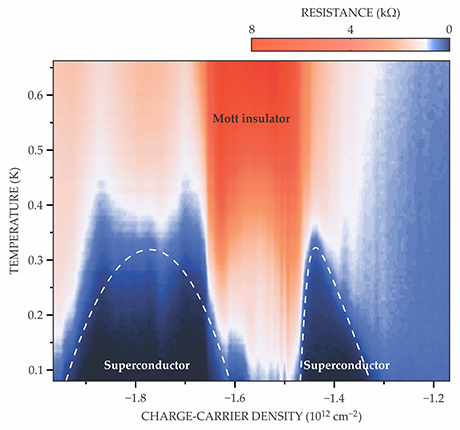Unconventional superconductivity discovered in graphene bilayers
DOI: 10.1063/PT.3.3913
Much of the appeal of the two-dimensional materials zoo—which includes graphene, hexagonal boron nitride, molybdenum disulfide, and many others—lies in the multitude of ways the atomically thin sheets can be stacked and combined to create heterostructures with novel properties. (See the article by Pulickel Ajayan, Philip Kim, and Kaustav Banerjee, Physics Today, September 2016, page 38
When two periodic lattices, atomic or otherwise, are overlaid and slightly offset, they can interfere to create a moiré pattern, named after a type of silken fabric whose construction gives it a rippled appearance. As figure
Figure 1.

The moiré pattern between two honeycomb lattices is quasiperiodic over a much larger scale than either lattice itself. Highlighted in yellow are the repeating regions where the hexagons in the two sheets nearly align.

Now MIT’s Pablo Jarillo-Herrero, his student Yuan Cao, and their colleagues have shown that the twist angle between two sheets of graphene can be exploited to even more dramatic effect: At a magic angle of approximately 1.1°, the two-layer stack becomes a superconductor. 2 Furthermore, superconducting twisted bilayer graphene bears a strong resemblance to the cuprates and other materials that superconduct at temperatures near 100 K or even higher. Although the graphene bilayers don’t have critical temperatures anywhere near that high, they constitute an enticing new platform for studying unconventional superconductivity that may yield new insights into the elusive phenomenon.
Strong coupling
Monolayer graphene gets many of its interesting properties from its unusual band structure. The valence and conduction bands meet in conical valleys, meaning that charge carriers have kinetic energy directly proportional to their momentum, just like photons and other relativistic particles do (see the article by Andre Geim and Allan MacDonald, Physics Today, August 2007, page 35
The same quasi-relativistic behavior is present in bilayer graphene with a twist angle of more than a few degrees. At those large angles, the sheets decouple and behave like independent monolayers. On the other hand, in ordinary bilayer graphene—with a twist angle of zero, at which the sheets are stacked just as they are in bulk graphite—the valleys are parabolic, energy is proportional to momentum squared, and charge carriers act like the massive particles that they are.
At some small twist angle, then, there must be a transition between those two qualitatively different band structures, and several papers 3 have hinted that in that crossover regime, the energy– momentum dispersion actually flattens out, so all electrons, regardless of momentum, have the same energy. Looked at another way, the density of states as a function of energy diverges. That so-called band flattening is typical of strongly correlated phases of matter, such as the electron fluid in a high-temperature cuprate superconductor.
Strongly correlated systems, which also include other quantum phases of matter, quark–gluon plasmas, and neutron stars, are notoriously difficult to understand, because the states of their constituent particles can’t be mathematically separated. Moreover, twisted bilayer graphene poses its own theoretical challenges. Standard computational methods for simulating electrons in a solid require that the system be periodic. But except at a discrete set of twist angles, moiré patterns are only quasiperiodic: Similar-looking regions appear at regular intervals, but the structure never exactly repeats. As a result, it was unclear just how band flattening would manifest itself in twisted bilayer graphene, or even at what twist angle it would occur.
Jarillo-Herrero and colleagues were studying twisted bilayer graphene experimentally when in 2016 they started to see hints of strong-coupling behavior at twist angles less than 2°. 4 They became aware of a paper published five years earlier in which Rafi Bistritzer and Allan MacDonald formulated a continuum model of the quasiperiodic structures and predicted singular electronic behavior at not just one but a series of twist angles. 5 The largest of those, and the one with the most severe band flattening, was 1.05°.
Thereafter, the MIT experimenters focused on twists near that magic angle. To ensure the sheets had good electronic quality, they sandwiched their graphene bilayer between thin flakes of insulating boron nitride. With a gate electrode, they adjusted the material’s charge-carrier density. Source and drain electrodes passed a current along the plane of the sheet, allowing measurements of its resistance.
The first hint that something unusual was going on came when they tuned the carrier density to about 1.5 × 1012 electrons per square centimeter and the conductivity dropped to zero. 6 The graphene bilayer became an insulator, but there was no gap in the density of states to account for the observed behavior. The researchers deduced that they were seeing a correlated insulator, in which strong correlations between charge carriers prevent them from moving around, despite an abundance of available states.
Because a Mott insulating phase, a type of correlated state, also shows up in the phase diagrams of some unconventional superconductors, Jarillo-Herrero and colleagues suspected that the unexpected insulating behavior was just the tip of the iceberg. To see what other surprises lay in store, they needed to refabricate their devices with six in-plane electrodes, not just two, and make their electrical measurements in a dilution refrigerator that could cool to 0.1 K. After several months of work, they had their results, as shown in figure
Figure 2.

Phase diagram of a graphene bilayer with a twist angle of 1.16°. A Mott insulating phase is flanked by two dome-shaped superconducting phases, reminiscent of the electron- and hole-doped phases of a high-temperature superconductor. The critical temperature, here just 0.3 K, can be increased to 1.7 K by changing the twist angle to 1.05°. (Adapted from ref.

Dial a superconductor
At first glance, twisted bilayer graphene might look unimpressive as a superconductor. Its critical temperature Tc is on the order of just 1 K. The sample that was probed in figure
But Tc doesn’t tell the whole story. Aluminum’s charge-carrier density is 10 000 times that of twisted bilayer graphene. That’s important, because carrier density represents a limit on how many electrons can pair up and condense into a superfluid. The lower the carrier density, the harder it is for the phonon-mediated pairing mechanism of the BCS theory to work. In fact, the true measure of a superconductor is better quantified by the ratio of Tc to carrier density. Looked at that way, twisted bilayer graphene is right in line with the most strongly correlated superconductors known: In terms of its electronic properties, it has more in common with high-Tc materials than with aluminum and its BCS cousins.
But graphene has a big experimental advantage over other unconventional superconductors: Tuning its carrier doping is as simple as adjusting the voltage on the gate electrode, so all parts of the phase diagram can be explored with a single device. In cuprate superconductors, on the other hand, superconductivity lives in the CuO2 planes, which are doped with electrons or holes by the atoms above and below. Adjusting the doping therefore requires making an entirely new material with slightly different chemical composition. At best, that’s tedious and challenging; at worst, it can be impossible.
For example, yttrium barium copper oxide (YBCO) can be doped with holes by adjusting the material’s oxygen content—indeed, hole-doped YBCO was the first material to superconduct at liquid-nitrogen temperatures—but it doesn’t lend itself to doping with electrons. Other cuprates allow electron doping but not hole doping. Twisted bilayer graphene admits the equivalent of both, continuously and easily.
Furthermore, it’s possible to tune the band structure itself by making new bilayers with slightly different twist angles. To do the same with the cuprates requires not just tweaking the chemical composition but completely changing it—from YBCO to bismuth strontium calcium copper oxide, say—and it’s not always clear what effects those complex chemical changes might have. Twisted bilayer graphene supports superconductivity over a range of at least 0.11°, maybe more, and Jarillo-Herrero and colleagues have already shown that tuning the twist angle changes not only Tc but also the structure of the phase diagram. Exploring the effect further could help to show just how material structure, density of states, and superconductivity are all connected. Ultimately, that approach may reveal the mechanism of high-Tc pairing and how to design materials with even higher Tc.
“The ability to dial the electronic band structure with a simple twist is an incredibly powerful new tool,” explains Eva Andrei of Rutgers University. “Until now, all superconductor discoveries were the result of serendipity or painstaking chemical synthesis. Twisted bilayer graphene strips away all the complications imposed by the chemistry of the high-Tc superconductors. This could be a huge step toward solving this 30-year-old puzzle.”
A matter of scale
In some ways, twisted bilayer graphene brings to mind the ultracold gaseous systems some groups are using to try to unlock the secrets of high-temperature superconductivity. (See Physics Today, August 2017, page 17
Twisted bilayer graphene is intermediate between optical lattices and crystalline superconductors in at least two ways. Its critical energy scale is below 100 K but well above 1 nK. And its length scale—as measured by the distance between the regions marked in yellow in figure
The size scale of the moiré pattern isn’t incidental. The carrier density that produces the Mott insulating phase, 1.5 × 1012 cm−2, corresponds to exactly two carriers per moiré unit cell. And simulations show that the charge density is strongly concentrated in the regions of lattice alignment, just like the atoms in the cold-gas experiments are confined to their optical traps. Graphene superconductivity, therefore, seems to have something to do with electron correlations on a 13 nm scale. That’s too small to image optically, but other technologies, such as nanoSQUIDs, could make it possible to directly probe the superconducting electronic state.
Graphene is just one of an ever-growing family of 2D materials, each with its own distinct flavor. There are 2D semiconductors, 2D ferromagnets (that Jarillo-Herrero helped to discover; see Physics Today, July 2017, page 16
References
1. C. R. Dean et al., Nature 497, 598 (2013); https://doi.org/10.1038/nature12186
L. A. Ponomarenko et al., Nature 497, 594 (2013); https://doi.org/10.1038/nature12187
B. Hunt et al., Science 340, 1427 (2013). https://doi.org/10.1126/science.12372402. Y. Cao et al., Nature 556, 43 (2018). https://doi.org/10.1038/nature26160
3. G. Li et al., Nat. Phys. 6, 109 (2010); https://doi.org/10.1038/nphys1463
E. Suarez Morell et al., Phys. Rev. B 82, 121407 (2010). https://doi.org/10.1103/PhysRevB.82.1214074. Y. Cao et al., Phys. Rev. Lett. 117, 116804 (2016). https://doi.org/10.1103/PhysRevLett.117.116804
5. R. Bistritzer, A. H. MacDonald, Proc. Natl. Acad. Sci. USA 108, 12233 (2011). https://doi.org/10.1073/pnas.1108174108
6. Y. Cao et al., Nature 556, 80 (2018). https://doi.org/10.1038/nature26154
